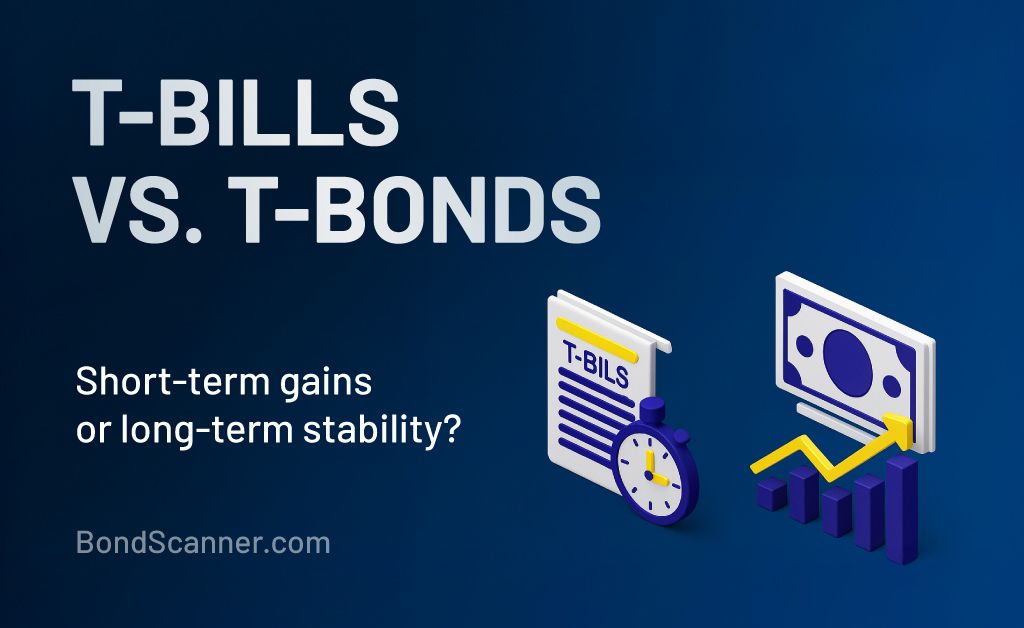Treasury Bills vs Treasury Bonds: Understanding the Difference
13 October 2025

What Are Treasury Bills (T-Bills)?
The Indian government regularly issues debt instruments like Treasury Bills (T-Bills) and Treasury Bonds to raise funds for its financial requirements. Both are considered safe, government-backed investments, but they differ significantly in tenure, interest rate, and structure.
Understanding the difference between Treasury Bills vs Treasury Bonds in India is essential for investors who wish to diversify their portfolios with low-risk, fixed-income securities.
This article explores what T-Bills and Treasury Bonds are, how they work, and their key distinctions.
Treasury Bills, commonly known as T-Bills, are short-term government securities issued by the Reserve Bank of India (RBI) on behalf of the Government of India.
They are zero-coupon instruments, meaning they don’t pay periodic interest. Instead, they are issued at a discounted price and redeemed at face value upon maturity — the difference being the investor’s return.
Key Features of T-Bills
Issuer: Government of India (via RBI)
Tenure: Less than one year (91, 182, or 364 days)
Interest: No regular interest; returns come from the price difference
Investment Purpose: Short-term liquidity management
Risk Level: Virtually risk-free due to sovereign guarantee
For example, if a 364-day T-Bill with a face value of ₹1,00,000 is issued at ₹96,000, the investor earns ₹4,000 at maturity — which represents the effective yield.
What Are Treasury Bonds?
Treasury Bonds, also known as Government Bonds or G-Secs, are long-term debt instruments issued by the Government of India to fund infrastructure projects, fiscal needs, or public welfare programs.
Unlike T-Bills, Treasury Bonds pay regular interest (coupon payments) throughout their tenure, usually every six months.
Key Features of Treasury Bonds
Issuer: Government of India
Tenure: Long-term, typically ranging from 5 to 40 years
Interest Rate: Fixed or floating coupon rate, paid semi-annually
Investment Purpose: Long-term capital funding for government projects
Risk Level: Extremely low due to sovereign guarantee
Treasury Bonds are preferred by long-term investors like pension funds, insurance companies, and conservative individual investors seeking predictable returns.
Treasury Bills vs Treasury Bonds: Key Differences
| Parameter | Treasury Bills (T-Bills) | Treasury Bonds |
|---|---|---|
| Issuer | Government of India (via RBI) | Government of India |
| Tenure | Short-term (91, 182, 364 days) | Long-term (5 to 40 years) |
| Interest Payment | No regular interest; issued at a discount | Pays fixed or floating interest semi-annually |
| Investment Type | Short-term liquidity instrument | Long-term capital investment |
| Returns | Difference between issue and face value | Regular coupon payments plus principal at maturity |
| Market Participants | Banks, financial institutions, and short-term investors | Insurance companies, pension funds, long-term investors |
| Risk Level | Low (sovereign-backed) | Low (sovereign-backed) |
T-Bills Interest Rate and Returns
The T-Bills interest rate (or yield) is not fixed but determined through competitive auctions conducted by the RBI.
As of 2025, the indicative yields for T-Bills in India are:
91-day T-Bill: Around 6.8% – 7.0%
182-day T-Bill: Around 7.1% – 7.3%
364-day T-Bill: Around 7.4% – 7.6%
These rates fluctuate based on market demand, inflation expectations, and RBI’s monetary policy stance.
Treasury Bonds Interest Rates
Treasury Bonds, unlike T-Bills, offer fixed coupon rates announced at issuance.
For example, a 10-year Government Bond might offer a 7.2% coupon rate, meaning investors receive 7.2% interest annually on the face value, typically split into semi-annual payments.
Long-term bond yields in India are influenced by:
Inflation trends
RBI policy repo rate
Fiscal deficit levels
Market demand for government securities
Treasury Bills and Treasury Bonds: Risk and Liquidity
Both instruments are backed by the Government of India, making them among the safest investments available.
However, they differ in liquidity and duration risk:
T-Bills are more liquid due to their short maturities and frequent trading.
Treasury Bonds carry interest rate risk, as their value may fluctuate with changing market rates, especially over long durations.
That said, both serve as vital components of the Indian bond market ecosystem and are actively traded by institutional and retail investors.
How to Invest in Treasury Bills and Treasury Bonds in India
Investors can purchase T-Bills and Treasury Bonds via:
RBI Retail Direct portal (direct participation in government securities)
Stock exchanges (secondary market)
SEBI-registered Online Bond Platform Providers (OBPPs) which offer simplified access to various fixed-income instruments.
These platforms ensure transparent pricing, regulated transactions, and secure settlements through exchange and clearing corporations.
Treasury Bills vs Treasury Bonds: Which Should You Choose?
Choosing between Treasury Bills and Treasury Bonds depends on your investment horizon and liquidity preference.
Opt for T-Bills if you’re looking for short-term, risk-free instruments for parking surplus funds.
Choose Treasury Bonds for long-term, stable income and capital preservation.
Both instruments complement each other in a diversified fixed-income portfolio.
FAQs
1. What is the meaning of T-Bills in India?
T-Bills are short-term government securities issued at a discount and redeemed at face value, offering returns based on the difference between the two.
2. What is the difference between Treasury Bills and Treasury Bonds?
T-Bills are short-term, zero-coupon securities, while Treasury Bonds are long-term instruments that pay periodic interest.
3. Are Treasury Bills risk-free?
Yes, T-Bills are backed by the Government of India, making them virtually risk-free and highly liquid.
4. What is the current T-Bill interest rate in India?
As of 2025, T-Bill yields range between 6.8% and 7.6%, depending on maturity and market conditions.
5. Can individual investors buy T-Bills and Treasury Bonds?
Yes, both can be purchased by individuals through RBI Retail Direct, stock exchanges, or SEBI-registered platforms like BondScanner.
Conclusion
Both Treasury Bills and Treasury Bonds play crucial roles in India’s debt market, serving different investor needs.
T-Bills are ideal for short-term parking of funds, while Treasury Bonds cater to long-term investment goals.
By understanding their features and differences, investors can make informed, risk-aware decisions aligned with their financial objectives.
Disclaimer
This blog is intended solely for educational and informational purposes. The bonds and securities mentioned herein are illustrative examples and should not be construed as investment advice or personal recommendations. BondScanner, as a SEBI-registered Online Bond Platform Provider (OBPP), does not provide personalized investment advice through this content.
Readers are advised to independently evaluate investment options and seek professional guidance before making financial decisions. Investments in bonds and other securities are subject to market risks, including the possible loss of principal. Please read all offer documents and risk disclosures carefully before investing.
Recent Blogs

Covered Bonds & Senior Secured Bonds Explained
An educational guide explaining covered bonds, senior secured bonds, what secured bonds mean, and how these instruments function in India’s bond market.
19 Dec 2025

Guide to Capital Gain Bonds (54EC) & Alternatives
An educational guide explaining capital gain bonds under Section 54EC, issuer options like PFC and SBI, eligibility rules, and alternatives for reinvesting sale proceeds.
19 Dec 2025

Bond ETFs in India: How They Work & When to Use Them
An educational guide explaining bond ETFs in India, their structure, returns, risks, and how products like Bharat Bond ETF and corporate bond ETFs function.
19 Dec 2025